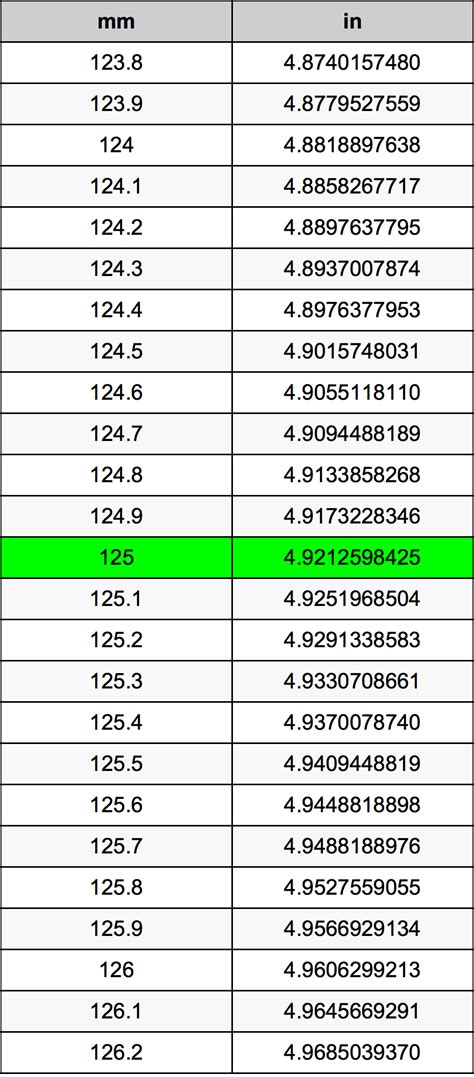How Many Inches Is 125 Mm
Kalali
Mar 29, 2025 · 4 min read

Table of Contents
How Many Inches is 125 mm? A Comprehensive Guide to Metric-Imperial Conversions
The question, "How many inches is 125 mm?" might seem simple, but it opens a door to a fascinating world of unit conversion and the importance of understanding different measurement systems. This comprehensive guide will not only answer this specific question but also delve into the broader context of metric-imperial conversions, providing you with the knowledge and tools to tackle similar conversions with confidence.
Understanding the Metric and Imperial Systems
Before we dive into the specifics of converting 125 millimeters to inches, let's establish a foundational understanding of the two measurement systems involved: the metric system (also known as the International System of Units or SI) and the imperial system (primarily used in the United States and a few other countries).
The Metric System: Simplicity and Standardization
The metric system is a decimal system, meaning it's based on powers of 10. This makes conversions within the system incredibly straightforward. The fundamental units are:
- Meter (m): The base unit of length.
- Gram (g): The base unit of mass.
- Liter (l): The base unit of volume.
Larger and smaller units are derived by multiplying or dividing by powers of 10, using prefixes like kilo (k, meaning 1000), centi (c, meaning 0.01), and milli (m, meaning 0.001). For example:
- 1 kilometer (km) = 1000 meters (m)
- 1 centimeter (cm) = 0.01 meters (m)
- 1 millimeter (mm) = 0.001 meters (m)
The Imperial System: A Legacy of Complexity
The imperial system, in contrast, is less standardized and more complex. It's based on a variety of historical units and their relationships are often not intuitive. Key units for length include:
- Inch (in): A fundamental unit.
- Foot (ft): 12 inches.
- Yard (yd): 3 feet.
- Mile (mi): 5280 feet.
Conversions within the imperial system often require remembering specific conversion factors, making it less user-friendly than the metric system.
Calculating 125 mm to Inches: The Conversion
Now, let's address the central question: How many inches are in 125 millimeters?
The key conversion factor to remember is that 1 inch is approximately equal to 25.4 millimeters. This is a crucial constant in metric-imperial conversions.
To convert 125 mm to inches, we can use the following formula:
Inches = Millimeters / 25.4
Plugging in the value, we get:
Inches = 125 mm / 25.4 mm/in ≈ 4.92 inches
Therefore, 125 millimeters is approximately 4.92 inches.
Beyond the Calculation: Practical Applications and Considerations
Understanding the conversion of 125 mm to inches extends beyond a simple mathematical calculation. It has practical applications in various fields:
Engineering and Manufacturing
Precision is paramount in engineering and manufacturing. Accurate conversions between metric and imperial units are crucial for ensuring parts fit together correctly and machinery functions as intended. Incorrect conversions can lead to costly errors and even safety hazards.
Construction and Architecture
The construction and architecture industries often deal with both metric and imperial measurements, especially in international projects. Accurate conversions are necessary for planning, designing, and executing building projects efficiently and safely.
Everyday Life
Even in everyday life, understanding these conversions can be helpful. For example, if you're buying furniture or electronics from a country that uses a different measurement system, knowing how to convert units can ensure you purchase items that fit your space.
Dealing with Precision and Rounding
It's important to note that the conversion we performed (125 mm ≈ 4.92 inches) is an approximation. The actual value has more decimal places. The level of precision required depends on the application. In some cases, rounding to two decimal places (as we did) is sufficient. In others, higher precision might be necessary.
Mastering Metric-Imperial Conversions: Tips and Tricks
Converting between metric and imperial units can feel challenging, but with practice and the right techniques, it becomes easier. Here are some tips:
- Memorize Key Conversion Factors: Knowing key factors like 1 inch = 25.4 mm, 1 kilometer = 0.621 miles, etc., is fundamental.
- Use Online Converters: Many free online converters are available to quickly perform conversions. However, it's still beneficial to understand the underlying principles.
- Practice Regularly: The more you practice converting units, the more comfortable you'll become. Try converting various measurements to reinforce your understanding.
- Understand Dimensional Analysis: This technique helps ensure you're using the correct conversion factors and canceling out units correctly.
- Pay Attention to Significant Figures: Maintain the appropriate level of precision based on the context of the measurement.
Conclusion: Embracing the Interplay of Measurement Systems
The question of how many inches are in 125 mm underscores the importance of understanding and efficiently converting between metric and imperial systems. While the metric system offers simplicity and standardization, the imperial system remains relevant in many contexts. Mastering these conversions is not merely an academic exercise; it's a practical skill with applications in numerous fields, from engineering to everyday life. By understanding the underlying principles and practicing regularly, you can confidently navigate the world of measurement and ensure accuracy in your calculations. Remember to always double-check your work and select the appropriate level of precision for your specific task.
Latest Posts
Latest Posts
-
How Long Is 2 Hours In Minutes
Mar 31, 2025
-
What Is 20 Of 70 Dollars
Mar 31, 2025
-
What Is 3 20 As A Percentage
Mar 31, 2025
-
1000 Km Is How Many Miles
Mar 31, 2025
-
What Is The Average Atomic Mass Of Silver
Mar 31, 2025
Related Post
Thank you for visiting our website which covers about How Many Inches Is 125 Mm . We hope the information provided has been useful to you. Feel free to contact us if you have any questions or need further assistance. See you next time and don't miss to bookmark.
